Foyer Lighting Trends for a Stylish 2021
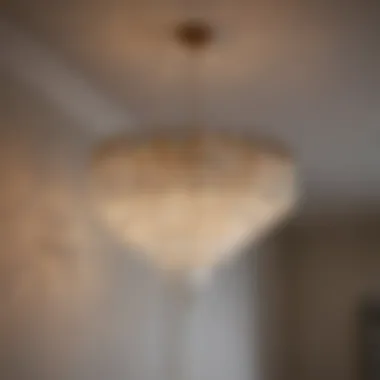
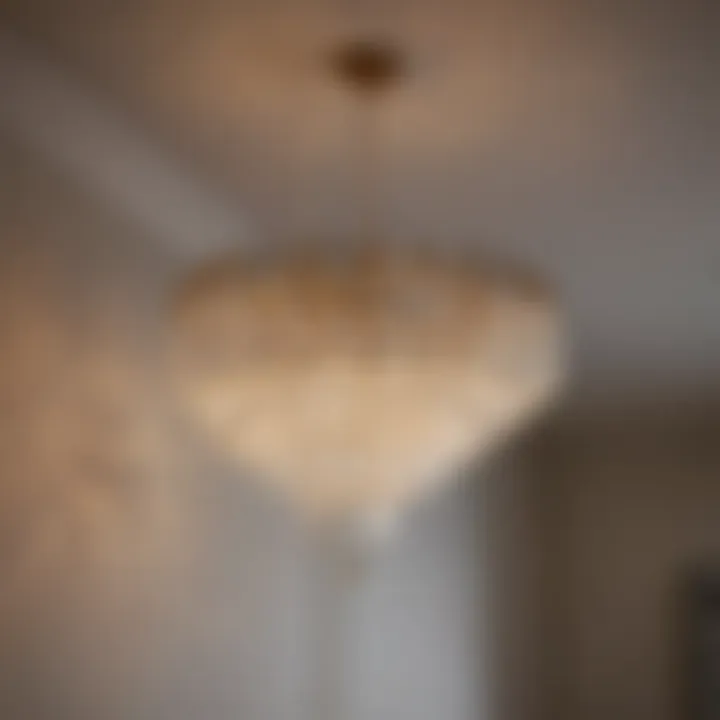
Intro
Foyer lighting plays an essential role in establishing the first impression of a home. As focal points of entryways, these areas must balance aesthetics with functionality. In 2021, various trends have emerged, shaping how homeowners and interior designers approach foyer lighting. From innovative designs to material selections, the right choices can elevate any entryway.
The year brought a blend of styles that cater to modern sensibilities while preserving warmth and hospitality. By exploring the evolving landscape of foyer lighting, we can uncover insights to enhance any space. Homeowners gain an advantage in understanding the trends that resonate with both practicality and beauty.
In this guide, you will find discussions centered on design inspiration, current trends in interior design, and notable color schemes for creating attractive entryways.
Preamble to Foyer Lighting Trends
Foyer lighting serves as a critical introduction to a home. Entryways are often the first impression one gets when entering a space. The right lighting creates an inviting atmosphere while ensuring safety and functionality. It highlights architectural features and offers warmth and clarity. In the context of 2021, several trends emerged that provide both aesthetic appeal and practical benefits. This article will explore these developments, focusing on their significance and how they impact overall interior design strategies.
The Importance of Foyer Lighting
The importance of foyer lighting extends beyond mere illumination. Proper lighting enhances the visual appeal of an entryway, setting the tone for the rest of the home. It plays a role in safety, preventing accidents in dimly lit areas. A well-lit foyer can also influence mood and perception. For instance, warmer tones offer a cozy feel, while cooler tones might provide a more modern and sleek appearance. Additionally, as home layouts have adapted to open concepts, foyer lighting must now compete with the natural light that floods in from other spaces. Therefore, making astute choices in foyer lighting not only reflects style but also maximizes functionality in a home.
Overview of Trends
In 2021, several trends shaped foyer lighting. One noticeable trend was the shift towards sustainable practices. Homeowners increasingly favored energy-efficient lighting solutions. This included the use of LED bulbs, which consume less energy and have a longer lifespan.
Another trend involved the integration of technology into lighting designs, with smart lighting systems becoming popular. These systems allow homeowners to control the ambiance remotely or automate lighting based on preferences.
Design-wise, there was a noticeable appreciation for minimalist aesthetics, where clean lines and simple forms dominated. This contrast with earlier preferences for ornate designs marked a significant shift in trends. Visually striking elements, such as large chandeliers or unique pendant lights, also became focal points in foyers, while wall sconces offered subtler, ambient light that complements larger fixtures.
The exploration of materials added further depth to foyer lighting in 2021. Many designers turned to a mix of metal, glass, and sustainable materials, creating versatile designs that could suit various tastes and styles.
Overall, the foyer lighting trends of 2021 reflect a blend of functionality and style, aimed at creating warm, inviting entryways that resonate with modern sensibilities.
Style Overview: Foyer Lighting Designs
Foyer lighting plays a crucial role in setting the aesthetic tone of a home. It is often the first impression guests receive, which can greatly influence their perception. The style of lighting not only serves a functional purpose but also enhances the overall decor, reflecting the homeowner's taste and personality. Adjusting the lighting can dramatically impact the ambiance, thus making the understanding of various designs essential for effective foyer design.
Different styles can bring a unique character to foyer spaces. From sleek modern fixtures to ornate traditional pieces, each style has distinct features and serves various functions. It is important to consider how styles complement the existing decor, ensuring a cohesive look throughout the entryway.
Contemporary Designs
Contemporary foyer lighting is characterized by clean lines and minimalistic forms. Fixtures in this category often highlight simplicity and functionality. Materials such as metal, glass, and even LED components dominate in modern designs, focusing on sustainability and energy efficiency.
One popular choice within contemporary lighting is the geometric pendant. It offers a central point of interest without overwhelming the space. Slimline wall sconces can provide additional illumination while maintaining a clean aesthetic.
Using cool color temperatures helps to accentuate the modern appeal, while adjustable brightness features add practicality, allowing the space to be tailored to specific moods or needs. Homeowners may find contemporary designs easier to integrate into more extensive modern decor.
Traditional Aesthetics
In contrast, traditional foyer lighting remains rooted in classic designs. This style often embraces rich materials such as wrought iron, crystal, and ornate detailing. Chandeliers are a cornerstone of traditional aesthetics, creating a grand focal point within the foyer.
Classic wall sconces can also enhance traditional designs. Their detailed craftsmanship adds historical context and warmth to the entryway. Fixtures in this category tend to use warmer light bulbs, which contribute to a cozy and inviting atmosphere.
Traditional styles may resonate well with homeowners who favor timeless elegance. However, careful consideration should be given to the size and scale of fixtures to maintain balance within the space.
Transitional Spaces
Transitional foyer lighting merges elements of both contemporary and traditional styles, creating a harmonious blend. This versatility makes it appealing to a broader audience. Fixtures often feature clean lines with subtle detailing.
The combination of modern functionality with classic elegance allows for unique interpretations of space. For example, a contemporary chandelier might incorporate traditional elements, pairing it elegantly with modern furniture pieces. Wall sconces in this category often possess simple silhouettes yet exhibit elegant finishes.
Choosing colors and textures that bridge the gap between styles can enhance the overall appeal. Warm neutrals mixed with metallic finishes can help to create a seamless flow from one style to another.
"Foyer lighting not only provides necessary illumination but also holds the power to define a home's character."
Material Choices in Foyer Lighting
Choosing appropriate materials for foyer lighting is essential for both aesthetics and durability. Foyer lighting should reflect personal style while also considering functionality. The right materials enhance the design and create a welcoming atmosphere. Homeowners can play with various materials to set the mood for their entryway.
Metal Fixtures
Metal fixtures are a popular choice for foyer lighting. They offer a sleek and modern look that complements contemporary designs. Different types of metals can give various appearances. For example, brass can add warmth and sophistication, while silver or chrome can suggest a more minimalist aesthetic.
- Durability: Metal fixtures are generally robust, making them suitable for high-traffic areas like foyers. They withstand wear over time and adapt to changes in decor.
- **Variety:**There is a wide range of finishes available, including matte, polished, or brushed. This allows homeowners to select a style that connects with their interior themes.
Considerations should include the overall theme of the space and the types of maintenance different metals require. Some metals may tarnish or corrode, so protecting them with appropriate coatings may be necessary.
"The choice of material can vastly improve a space's aesthetic appeal, turning a simple entrance into a striking focal point."
Glass Elements
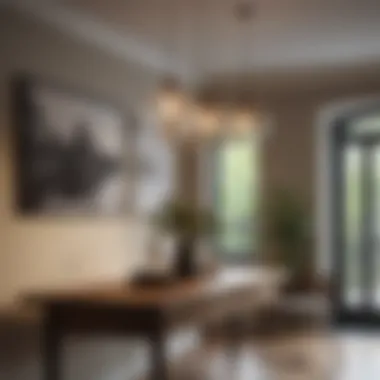
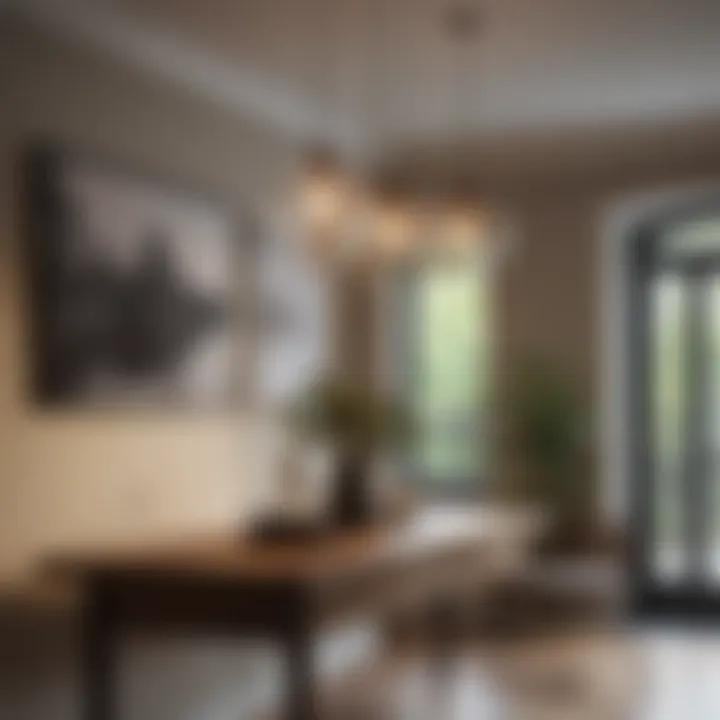
Glass elements are increasingly sought after in foyer lighting. They provide a beautiful interplay of light and shadow. Glass fixtures can create a sense of spaciousness, making smaller foyers appear larger. They also allow for more creative designs, such as pendant lights and chandeliers that showcase intricate glass work.
- Light Diffusion: Glass can soften the intensity of light. Different glass textures and colors can provide unique visual experiences.
- Customization: Homeowners can opt for colored or patterned glass to reflect personal taste. This versatility helps in creating distinctive lighting solutions.
However, fragile nature requires careful handling. Glass fixtures may be inappropriate for households with small children or pets.
Sustainable Materials
Sustainable practices are vital in today's design decisions. Foyer lighting can also incorporate eco-friendly materials. Using reclaimed wood or recycled metals not only supports the environment but adds character to the space.
- Responsibility: Choosing sustainably sourced materials reflects a commitment to the planet. Enhancing entryways with responsibly sourced options increases awareness among guests regarding environmental consciousness.
- Natural Aesthetics: Sustainable materials often provide a rustic or natural appearance that can complement various styles. This trend supports a growing desire for connecting interior spaces with nature.
Interior design enthusiasts can feel proud of their choices, making a statement while being considerate of ecological impacts. Careful selection of materials in foyer lighting becomes not just a design decision, but a lifestyle choice.
Types of Foyer Lighting
Creating the right ambiance in a foyer is essential. The type of lighting you choose can greatly influence both the aesthetic appeal and functionality of the space. Proper foyer lighting can provide warmth, set the mood, and ensure safety. Each type of lighting serves a unique purpose and contributes to the overall design.
Understanding these various types is crucial for homeowners and designers to make informed decisions that align with their style and practical needs. Here, we examine the essential types of foyer lighting.
Chandeliers
Chandeliers are often seen as the epitome of elegance in foyer lighting. They draw attention and can create a stunning focal point in the entryway. Chandeliers come in various designs, from classic crystal to modern geometric styles.
- Benefits: They provide ambient light, quickly transforming a simple foyer into a sophisticated space.
- Considerations: The size of the chandelier should relate to the dimensions of the foyer. A too-small chandelier may seem lost in a large space, while one that is too large can overwhelm.
Installation height is also important. Hanging it too high may negate its visual impact, while too low can restrict mobility.
"The chandelier serves not only as a light source but also as an art piece that can tie the entire decor together."
Pendant Lights
Pendant lights offer versatility and are available in numerous styles, making them suitable for different tastes. Unlike chandeliers, pendants tend to be more understated yet impactful. They are generally hung at a lower height and can be used individually or in clusters.
- Benefits: They provide focused lighting, allowing for targeted illumination in specific areas. This is particularly useful for adding light to darker corners of a foyer.
- Considerations: When selecting pendants, it’s important to consider their height and scale. They should complement other design elements without overwhelming the space.
Choosing the right bulb is also helpful for creating the desired ambience.
Wall Sconces
Wall sconces are helpful for enhancing a foyer’s light layer while saving space. They can highlight architectural features and artwork, helping to create depth in the entryway.
- Benefits: They provide ambient and accent lighting in a more subtle way compared to chandeliers and pendants.
- Considerations: The placement of wall sconces is crucial. They should be installed at eye level for optimal effect. Also, consider how many sconces are necessary for sufficient illumination without becoming cluttered.
Recessed Lighting
Recessed lighting is a discreet option that provides a clean, modern aesthetic. They are installed into the ceiling, which saves visual space while offering effective light distribution.
- Benefits: They can be strategically placed for optimal lighting in a foyer, providing an unobtrusive solution. Recessed lights are great for supplementing other types of lighting.
- Considerations: Ensure proper installation, as incorrect spacing can lead to harsh shadows or uneven lighting. Dimming capabilities can enhance their functionality, allowing for different moods.
Each type of foyer lighting carries unique characteristics and potential benefits. By thoughtfully considering these options, homeowners can create a well-rounded and inviting entryway.
Color Temperature and Brightness
The selection of color temperature and brightness is essential in creating the right atmosphere in foyer lighting. Both elements affect not just visual appeal but also how one feels upon entering a home. Various options can create different moods, impacting the overall experience of the space.
Warm vs. Cool Lighting
When discussing lighting, the terms warm and cool describe the color temperature, measured in Kelvin. Warm lighting, typically around 2700K to 3000K, emits a yellowish hue. This kind of light creates an inviting and cozy atmosphere. It is well-suited for foyers meant to feel welcoming, especially in homes that embrace a cozy or rustic style.
On the other hand, cool lighting ranges from 4000K to 6500K, often giving off a bluish tint. Cool lighting is associated more with modern, streamlined designs and can offer a refreshing, more energized feel. Some homeowners may prefer this style, corresponding with contemporary aesthetics. Therefore, choosing between warm and cool lighting depends on the desired ambiance and design style.
Adjustable Brightness Features
Adjustable brightness features are becoming increasingly popular in foyer lighting. They allow homeowners to control the intensity of light, adapting to various needs. For example, brighter settings can be used during the day to illuminate the space effectively, while softer settings may be more appropriate for evening gatherings.
The implementation of dimmers offers flexibility. These devices can provide different lighting scenarios, from vibrant brightness when entertaining guests to a more subdued atmosphere for quiet evenings. In addition, some modern lighting fixtures include app-controlled settings. This technology allows for remote adjustments, enhancing convenience.
"The ability to control both brightness and color temperature can significantly improve the functionality and aesthetics of any foyer."
Integrating Technology in Foyer Lighting
Integrating technology into foyer lighting has become more significant in recent years, as it brings together aesthetics and practicality. In 2021, technology in lighting fixtures offered not just illumination but also enhanced functionality. This transformation is essential for homeowners and designers looking to create versatile and smart entryways. One major advantage of digital lighting solutions is the ability to customize the ambiance easily to suit various moods or purposes.
When considering integrating technology, several factors come into play. User-friendliness is paramount; systems should be simple to operate for everyone, including guests. Also, ensuring compatibility with existing home automation systems is critical. It allows homeowners to centralize control of all their lighting through one interface, simplifying daily routines and improving overall convenience.
Furthermore, energy efficiency is vital. Many modern lighting systems incorporate features like motion sensors and adaptive brightness controls. These technologies not only save energy but also extend the lifespan of the lighting fixtures. In all, integrating technology into foyer lighting represents a merger of form and function that cannot be overlooked.
Smart Lighting Solutions
Smart lighting solutions are at the forefront of foyer lighting trends in 2021. They provide homeowners with unprecedented control over their lighting systems. Through smartphone apps, users can adjust brightness and color temperature, set schedules, and even create lighting scenes that fit specific activities. For example, a warm glow is perfect for intimate gatherings, while bright light can enhance visibility when moving in and out of the house.
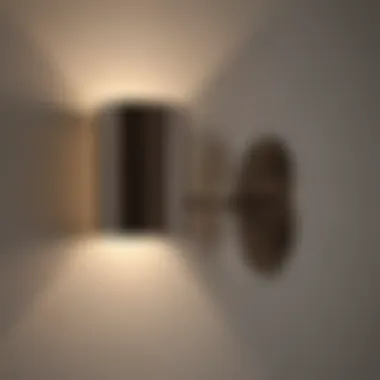
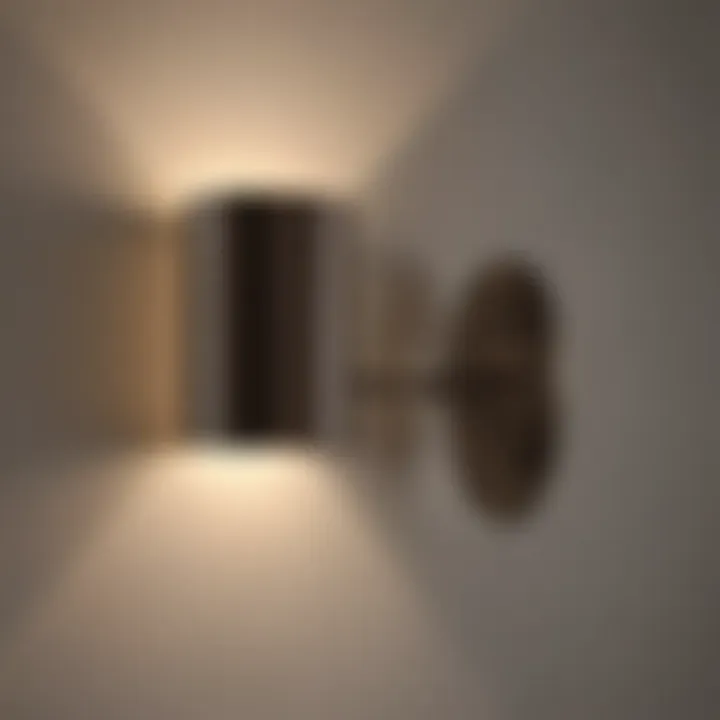
Some popular smart lighting options include:
- Philips Hue
- LIFX
- Wyze
These solutions rely on Wi-Fi or Bluetooth for connectivity. It is essential to ensure that the chosen system can operate smoothly, especially in larger homes where signal strength may vary.
"Smart lighting not only enhances aesthetic appeal but also adds functionality that aligns with modern living, offering convenience and style together."
Control Systems
Control systems in foyer lighting are crucial for maximizing the benefits of smart technology. In 2021, various control systems emerged, catering to different preferences and needs. These systems can be divided into two primary categories: standalone and integrated solutions.
- Standalone Systems: These involve remote controls or apps that operate specific lights or groups of lights independently. Users can control individual lighting elements without affecting the entire setup.
- Integrated Systems: These offer a cohesive solution, linking all lighting fixtures to a central hub. Homeowners can manage their entire lighting scheme from a single interface, often including dimmer controls and automation features. This option is more suitable for those looking to create an entire home lighting network.
Overall, the choice of control system will depend on the homeowner's lifestyle, the extent of their foyer lighting setup, and personal preferences. The integration of technology in foyer lighting can transform how spaces are used, making them more welcoming and adaptable.
Designing for Space and Scale
When considering foyer lighting, the concepts of space and scale play a crucial role in achieving a harmonious design. The foyer is often the first impression of a home. This makes thoughtful lighting choices essential for creating an inviting atmosphere. Proper design can enhance the visual appeal, making the entryway feel spacious and welcoming.
Assessing Foyer Dimensions
To create effective lighting, one must first assess the specific dimensions of the foyer. Taking accurate measurements is vital. Consider the height, width, and depth of the space. A compact foyer may benefit from brighter, more focused lighting, while larger areas can handle more expansive fixtures.
- Wall Height: A high ceiling allows for larger chandeliers, creating a dramatic effect.
- Width and Length: Ensure the fixtures do not overwhelm or undersell the space. A balanced proportion enhances aesthetics.
- Natural Light Sources: Assess windows or openings for the impact of available daylight. This can inform choices about light intensity and color temperature.
An essential part of assessing dimensions is understanding the relationship between the lighting and the other elements present, such as furniture or architectural features.
Creating a Focal Point
Creating a focal point in the foyer is another effective way to enhance lighting design. A well-placed light fixture can draw attention to key features, setting the tone for the entire home. Examples of effective focal points include:
- Statement Chandeliers: A bold chandelier can serve as a centerpiece, highlighting the area.
- Sconces: Wall sconces can add both functionality and visual interest. Position them at eye level for the best effect.
- Art Displays: Using lighting to accentuate art pieces can transform the foyer into a unique showcase.
The goal is to ensure the focal point complements the overall design theme. This can align with contemporary, traditional, or transitional styles, depending on personal preferences.
As a final note, layered lighting approaches can enhance this further by combining ambient, task, and accent lighting. Ultimately, designing for space and scale effectively leads to an inviting entryway, showcasing both style and sophistication.
Layered Lighting Approaches
Layered lighting is a critical concept in creating a well-designed foyer. This approach emphasizes using multiple light sources to enhance both function and aesthetic. When applied effectively, layered lighting can dramatically improve the ambiance of an entryway, ensuring it is both welcoming and practical.
The main benefit of using a layered approach is the ability to control illumination based on different needs and settings. By combining ambient, task, and accent lighting, homeowners and designers can achieve a versatile lighting environment that adapitates to various situations. Furthermore, this method helps in reducing shadows and dark areas, making spaces feel larger and more inviting.
Ambient Lighting
Ambient lighting forms the foundation of any layered lighting scheme. It provides an overall illumination that fills the entire space without causing glare. In a foyer, this can be achieved through ceiling-mounted fixtures, such as chandeliers or recessed lighting. The goal of ambient light is to create a comfortable reading level of illumination while allowing for other elements to stand out.
Considerations for ambient lighting include:
- Type of fixture: Chandeliers can offer style, while recessed lights are more minimal and modern.
- Brightness levels: Ensure the brightness is sufficient to light the space but balanced to avoid overly harsh light.
- Ceiling height: Higher ceilings might require more powerful ambient fixtures or multiple light sources.
Task Lighting
Task lighting is essential for specific activities that require focused light. In a foyer, this can involve lighting areas where keys are stored or shoe racks are organized. Table lamps or wall-mounted lights can be practical choices for enhancing visibility in these areas.
Considerations for task lighting include:
- Directional capability: Fixtures that can be directed to specific areas can improve functionality.
- Layering with ambient light: Ensure task lighting does not create competing shadows with ambient sources.
- Style: The design of task lighting should complement the overall foyer style without overpowering it.
Accent Lighting
Accent lighting serves to highlight particular areas or features within the foyer. This might include illuminating artwork, architectural elements, or decorative accessories. By drawing attention to specific details, accent lighting can add depth and interest to the overall space.
Considerations include:
- Placement: Light fixtures should be positioned strategically to highlight the desired focal point effectively.
- Color temperature: Ensure the color of accent light complement the ambient light to maintain a cohesive look.
- Flexibility: Consider using dimmers to adjust the intensity of accent lighting for various occasions.
Key Insight: Utilizing layered lighting techniques allows for optimized control over the atmosphere in the foyer, making it adaptable for different times of day or occasions.
The Role of Accessories in Foyer Lighting
In the realm of foyer lighting, accessories are essential not only for aesthetic appeal but also for enhancing functionality. They contribute significantly to the overall atmosphere and usability of this often-overlooked space. Accessories can elevate the entryway by tying together various design elements while ensuring that the lighting is both effective and inviting.
The right accessories can accentuate the characteristics of the foyer, creating a warm welcome for guests. Consideration should be given to how these elements interact with primary lighting fixtures. Accessories such as decorative mirrors, stylish switch plates, and tasteful artwork can work together with lighting to craft a cohesive look. Therefore, the role of accessories in foyer lighting transcends mere decoration; it also includes improving the ambiance and precise illumination to guide visitors.
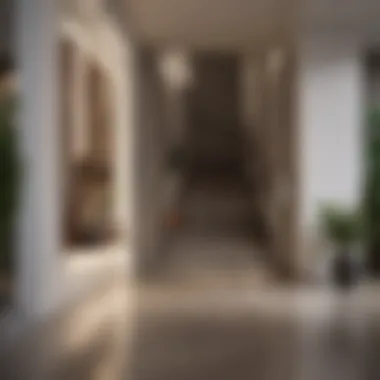
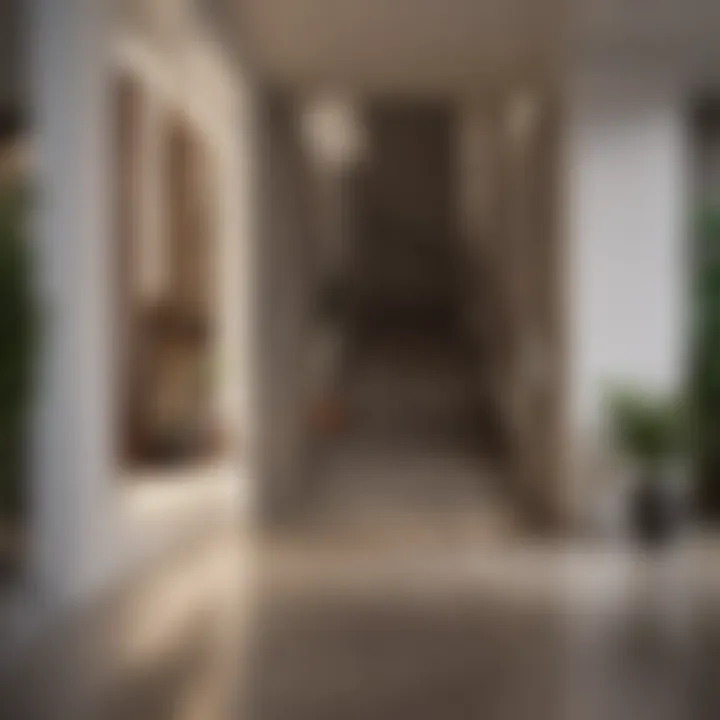
"A well-equipped foyer acts as a bridge, preparing guests for the rest of the home."
Decorative Elements
Decorative elements play a crucial role in enhancing the visual appeal of foyer lighting. These accessories can transform the ordinary into the extraordinary. For instance, mirrors not only amplify light but also create an illusion of space in smaller entryways. Hanging decorative art or photographs near light sources can generate interesting shadows and textures, contributing to the artistic feel of the room.
When selecting decorative accessories, consider the following:
- Style coherence: The accessories should align with the overall theme of the home, whether contemporary, traditional, or eclectic.
- Scale: Ensure that the size of decorative items complements the dimensions of the foyer, neither overwhelming nor underwhelming the space.
- Material choice: Mixing materials like wood, metal, and glass can add depth and interest without creating visual clutter.
Functional Additions
Functional accessories in foyer lighting serve practical purposes while adding style. These include items that not only decorate but also enhance the usability of the space. For example, motion-sensor lights can be practical, ensuring the foyer is well-illuminated when someone enters. Also, using task lighting near seating areas or tables can provide adequate light for specific activities like reading or managing deliveries.
Key functional accessories to consider:
- Smart bulbs: They allow adjustments to brightness and color temperatures, providing versatility.
- Lighting controls: Dimmer switches enable customized lighting environments based on the time of day or occasion.
- Comfortable seating: A small bench or chair can serve as a practical addition, complemented by suitable lighting to create a cozy reading nook or a convenient spot for putting on shoes.
In summary, accessories in foyer lighting should not be understood simply as decorative pieces. They are integral to crafting an inviting and functional entryway. By carefully selecting both decorative elements and functional additions, homeowners can create a foyer that reflects their personality and enhances the overall experience for anyone entering their home.
Sustainable Practices in Foyer Lighting
Sustainable practices in foyer lighting have become increasingly significant in recent years. As concern for the environment grows, so does the demand for energy-efficient and eco-friendly solutions. Sustainable lighting not only reduces energy consumption but also contributes to lower electricity bills. Homeowners and designers are more aware of how their choices impact the planet. In this context, sustainable practices do not just meet environmental standards; they reflect personal values and lifestyle choices.
Energy-Efficient Lighting
Energy-efficient lighting solutions, such as LED fixtures, have gained popularity due to their low energy consumption and long lifespan. Compared to traditional incandescent bulbs, LEDs can consume up to 80% less energy. This is a notable benefit for those looking to create a warm and inviting entryway while keeping utility costs manageable.
Besides cost savings, energy-efficient lighting is often designed for versatility. Many LED options come with adjustable brightness features. This capability allows homeowners to modify the intensity of light to suit their mood or time of day, enhancing the overall ambiance of the foyer. Furthermore, using energy-efficient lighting can qualify homeowners for energy rebates or incentives, adding to the overall value of the investment.
Responsibly Sourced Materials
The choice of materials for foyer lighting fixtures plays a critical role in sustainability. Homeowners are increasingly leaning toward products that are made from responsibly sourced materials. Fixtures crafted from recycled metals or sustainably harvested wood minimize the environmental impact of manufacturing.
Selecting lighting made from sustainable materials supports not just environmental health but also ethical manufacturing practices. Many brands now specify their sourcing, allowing consumers to make informed choices. Each time a homeowner chooses a responsibly sourced product, they contribute to a larger movement toward eco-friendliness in home design.
"Sustainable lighting practices represent a fusion of style and responsibility in home design."
Adopting sustainable practices in foyer lighting is not merely a trend; it is a progressive shift in how we design our living spaces. There is a growing awareness of the benefits of energy-efficient lighting and responsibly sourced materials. This shift is not only beneficial for the environment but also enhances the aesthetic and functional appeal of the foyer.
Future Trends in Foyer Lighting
As homeowners become more aware of the significance of foyer lighting, the future trends in this area are gradually shaping the way spaces are illuminated. Understanding these trends is essential, as they can elevate the aesthetics and functionality of entryways. Moreover, these trends reflect broader changes in technology and consumer preferences. They offer a glimpse into how foyer lighting can evolve to meet both practical needs and evolving design expectations.
Emerging Technologies
One of the most significant shifts in foyer lighting is the integration of emerging technologies. Smart lighting systems provide enhanced control and versatility. For instance, homeowners can adjust brightness, color temperature, or even the entire lighting scheme through mobile applications or voice commands. This technology not only improves convenience but also allows customization according to individual preferences.
With the rise of LED lighting, efficiency has become a priority. LEDs consume less energy compared to traditional lighting options, leading to lower electricity bills. Furthermore, advancements in LED technology now enable options that mimic natural light more closely. This gives the foyer a more inviting feel. Also, features such as motion sensors and automatic timers contribute to energy savings and added security.
"Smart lighting is no longer a luxury; it has become a staple in modern lighting design."
In addition to energy efficiency, technological innovations like smart home integration are becoming common. Systems from brands such as Philips Hue and Lutron provide seamless connectivity with other smart home devices, like security cameras and climate control systems. This interconnectedness enhances the foyer experience, making it a crucial part of the overall home environment.
Shifting Aesthetic Preferences
Aesthetic sensibilities in foyer lighting are continuously changing. Homeowners now favor designs that reflect personal style while remaining functional. Minimalism has gained popularity, where clean lines and less clutter are desired for a sleek look. This trend highlights the importance of choosing fixtures that harmonize with the existing décor of the space.
In contrast, there is also a movement towards bold statements. Unique light fixtures, including artistic chandeliers or sculptural wall sconces, are being used to become focal points upon entry. This juxtaposition of minimalist and statement pieces showcases the diverse preferences in foyer lighting.
Additionally, materials play an essential role in aesthetic trends. Natural materials such as wood or stone are favored for their warmth and organic feel. Homeowners are increasingly opting for sustainable products, reflecting a rising consciousness about environmental impacts. By choosing eco-friendly options, they can enhance the beauty of their entryways while supporting responsible manufacturing practices.
As contemporary designs continue to evolve, they often pay homage to historical styles. This blend results in transitional pieces that can appeal to a broader audience, bridging the gap between old and new. The key takeaway for homeowners is to adopt a personalized approach that balances functionality and aesthetic appeal, thus crafting a foyer that invites and impresses.
Culmination: Bringing it All Together
In this article, we explored various trends in foyer lighting that emerged in 2021. The conclusion serves as a synthesis of the insights and information discussed, reiterating the importance of foyer lighting not just as a practical necessity, but also as an integral part of home design. The foyer is the first space guests see when they enter your home. Therefore, achieving an inviting atmosphere starts with lighting choices.
Effective foyer lighting improves visibility and enhances safety. It also allows homeowners to reflect their personal style and preferences. The selection of fixtures, materials, and colors can significantly impact the overall aesthetic. Considering scalable designs and balanced lighting layers can directly influence the ambiance experienced in an entryway. Notably, integrating technology and energy-efficient solutions reflects modern living, making the foyer both functional and stylish.
Recap of Key Points
- Importance of Lighting: Foyer lighting creates the initial impression of a home, highlighting its design and aesthetic.
- Diverse Options: Various lighting types exist such as chandeliers, pendant lights, wall sconces, and recessed options, catering to different styles and functional needs.
- Material Variety: The choice of materials, from metals to sustainable options, enriches the design and allows for personalization.
- Technological Integration: Smart lighting systems can enhance functionality while providing energy savings.
- Personal Expression: Foyer lighting is an opportunity for homeowners to showcase their unique tastes.
Encouraging Personal Style
Every homeowner can approach foyer lighting as a personal statement. Individual styles can be reflected through the selection of fixtures, colors, and arrangement. Incorporating personal elements may involve choosing a piece that resonates with individual experiences or aesthetics.
Consider the existing decor. For instance, modern fixtures may clash with traditional interiors. Instead, blend styles to maintain continuity while expressing uniqueness. Accessorizing with decorative elements reinforces the desired mood and personality. Simple additions, like art pieces or plants, can make the space more inviting.
Ultimately, foyer lighting is an essential component of a well-designed home. Those who take the time to understand their choices can elevate their entryways significantly.



